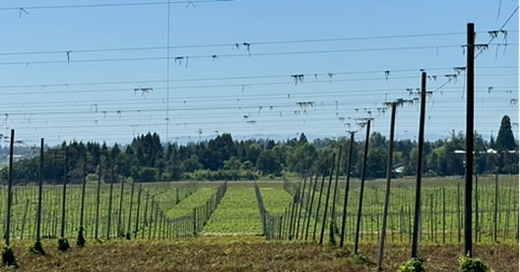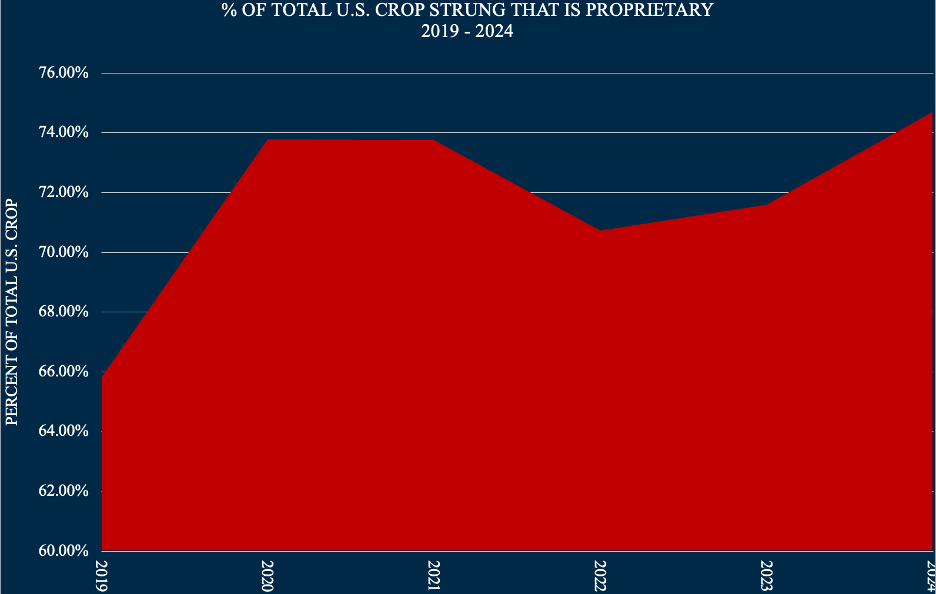How a Hostile Takeover Threatens Your Hop Supply
Hidden trends in the USDA strung for harvest numbers
The hop industry is approaching a tipping point. It’s not because of the size of the acreage reduction. It’s the way it happened and who was responsible.
The most recent USDA report is evidence that competition in the hop industry is dying. Once the surplus has been eliminated, if brewers do not purchase more public varieties, there are several ways the brewing industry will suffer.
1) There will be fewer hop varieties available.
2) Available varieties will be proprietary.
3) Hops will be more expensive than today and their prices will increase every year.
4) Mandatory contracts will come with ominous terms and conditions.
Once the cartel recovers from the surplus and resecures their monopoly, they will have carte blanche over prices and variety availability. This may seem like a ridiculous prediction today. In 2024, we are still 3-4 years away from these things becoming obvious. By then, it will be too late to change course.
To all brewers out there, large and small, if you don’t want the prices of your hops dictated to you, and if you don’t want merchants locking you into long-term contracts with draconian terms and conditions, it’s important that you share the information in this article with other brewers. The wider you can spread the message the greater the chance you will change the direction of the hop industry. I have kept these articles free and easy to share to make that happen. Now it’s all up to YOU. You will get the hop industry you deserve.
HOP ACREAGE STRUNG REPORT : Analysis
If you’ve not already seen the strung report, it’s available for you to download here. There have been several other people who have rushed to report the statistics. In my opinion, the data is the least interesting aspect of the strung report. You can read those for yourself on the USDA web site … and you should. The story behind those numbers is much more important. They reveal that a hostile takeover of the U.S. hop industry is happening now that will affect independent farmers worldwide.
The surplus was led by the demand for proprietary varieties. You might think the correction might involve reducing the acreage of more proprietary than public varieties. Not so! The reduction is also not equally distributed among independent farmers and those with ownership in a merchant company. While the industry is experiencing a hop cycle of sorts, the dominance of proprietary varieties makes this correction different than any other[1]. Along with a disproportionate amount of acreage, independent farmers have lost their freedom. They are no longer free to decide the varieties they produce or the prices at which they can sell them.
The winners are being chosen … not by the market, but by decree. The winners in the 2024 hop industry will be those that are allied with the owners of the popular proprietary varieties. They won’t be the best or the most efficient farmers. Like the Soviet Politburo, central planners have decided who will continue to produce and how much will be allocated to them[2]. When profitable, they will favor their farms and those of their cronies[3].
“The proletariat will use its political supremacy to wrest, by degrees, all capital from the bourgeoisie, to centralise all instruments of production in the hands of the State” [4]
- Karl Marx – Manifesto of the Communist Party, Chapter 2
THE TREND IS NOT YOUR FRIEND
In 2024, 74.71% of hops strung in the Washington, Oregon and Idaho (i.e., the Pacific Northwest (PNW)) are private varieties owned by a few people whose wealth has increased beyond imagination during the past decade[5]. Proprietary variety royalties likely exceeded $200 million during that time[6][7].
FUN FACT:
The previous record for proprietary acreage was set in 2020 when 73.78% of the U.S. crop produced were branded proprietary varieties.
The market concentration is thriving during the acreage cuts demonstrating that the power resulting from proprietary varieties is effective in both buyers’ and sellers’ markets (Figures 1 & 2). The trend is not in the best interest of brewers.
Figure 1. Percentage of proprietary hop varieties harvested in the PNW 2000-2023
Source: USDA NASS
Figure 2. Percentage of proprietary hop varieties strung in the PNW 2019-2024
Source: USDA NASS
WEAPONIZED HOPS
The intention of a patent is to give the inventor an exclusive 20-year period to recoup their investment[8][9][10]. Hop patent owners want to extend their patent rights beyond that 20-year period[11]. That’s why they always use the brand name together with the patent name. I believe the future will see the continued weaponization of branded proprietary hop varieties to extort billions of dollars from the brewing industry. They’ve already proven that’s possible.
Complicating things for independent merchant/farmers … owners of the most popular proprietary varieties also own the world’s largest hop processing and storage facilities and control global distribution networks. Merchant/farmers risk being ostracized if they oppose the cartel and their proprietary variety dominance. Rather than complain, they self-censor their speech.
Proprietary varieties enable supply controls. This allows them to dictate price. The consequences of the 2023 and 2024 U.S. acreage reductions will make and break some farms. It may seem strange to tout the advantages of proprietary varieties during the hop surplus they caused[12]. Traditional contracting methods, greed and untested merchant/farmer power combined with a brewer fear of missing out (FOMO) created the surplus. Human nature was responsible. The surplus will be gone in a few years. I believe when that happens the hop and brewing industries will witness the dominance possible via proprietary varieties.
HOPOCALYPSE NOW
According to the USDA, public hop variety acreage was cut by 32.82% between 2023 and June 2024. That’s almost double the proprietary variety acreage reduction, which declined by 16.53%[13]. Public varieties and everything they represent are being targeted for destruction. Greater market concentration is a goal of the hopocalypse. I wrote about that in my April 2024 article, “Will Craft Beer Bring the Hopocalypse”.
The industry is consolidating into fewer hands. Those hands reside in Washington State. Without change, independent merchant/farmers worldwide will disappear. Those with proprietary variety ownership believe they are safe today[14]. They may be safer than some of their competitors. For that reason they have been lulled into a false sense of security. Their time will come. The hop industry is a zero-sum game. Merchant/farmers are not content if somebody else is making money they could be making. I have experienced the jealousy and envy resulting from people whose love of money surpasses their moral decency.
“For the love of money is the root of all evil: which while some coveted after, they have erred from the faith, and pierced themselves through with many sorrows.”
- 1 Timothy 6:10 KJV
Three years ago, independent American farmers thought they were safe. Today, they know that’s not true. As I discussed in my June 10, 2024 article, consolidation has begun at the farm level[15]. Mega corporate hop farms will be the future unless brewers seek an alternate path. If a farm can produce 4,000 acres (1,619 ha.) of hops, it can produce 10,000 (4,048 ha.). It’s a management issue. In the long-term, every hop farmer is at risk.
BREWERS : YOU ARE THE RESISTANCE
What can you do to change the situation? If you’re a brewer … craft or macro … regardless of where in the world you brew … the solution is simple. Support independent hop farmers. Buy Public. It doesn’t matter who you buy from, but buy public. When you buy public, you enable independent farmers to stay in business. If you care about paying reasonable prices, buying public encourages competition. Buying public will strengthen the public breeding programs that can also produce amazing varieties.
Buying public is the one thing you can do that will make a difference. The brewing industry survived for centuries without proprietary hop varieties. There is no reason brewers must depend on them now.
Increased market concentration guarantees increased prices, encourages inefficiency and discourages innovation, which leads fewer varieties from which to select[16]. When the hop market is controlled by a cartel, the needs of the cartel itself will be the priority. Brewers need only to look at prices and contracting terms over the past decade to get an idea of what is yet to come.
[1] https://brewingindustryguide.com/rightsizing-the-hop-market/
[2] https://www.economicshelp.org/blog/glossary/central-planning/
[3] https://corporatefinanceinstitute.com/resources/economics/free-market/
[4] https://www.marxists.org/archive/marx/works/1848/communist-manifesto/ch02.htm
[5] For the sake of this article, I have assumed that half of the varieties listed in the “other” and “experimental” categories are proprietary. Based on varieties like Pekko®, ADHA-871, which were not independently reported in the June 2024 survey, it is reasonable to assume 50% of the other and experimental categories are proprietary.
[8] https://patentmastery.com/what-happens-when-a-patent-expires/
[9] https://www.uspto.gov/patents/maintain
[10] https://www.upcounsel.com/expired-patents-uspto
[12] https://mackinnonreport.substack.com/publish/posts/detail/145486047?referrer=%2Fpublish%2Fposts
[13] These calculations were achieved by assuming half of the “other” and “experimental” acreage was proprietary. Then, the difference between the USDA acreage strung reports from 2023 and 2024 was calculated.
[15] https://mackinnonreport.substack.com/publish/posts/detail/145486047?referrer=%2Fpublish%2Fposts
[16] https://www.oecd.org/daf/competition/market-concentration.htm










